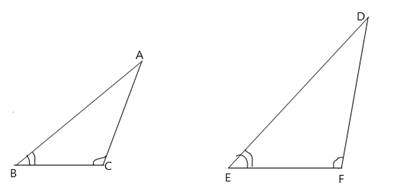
a.
To calculate: The ratio of sides AB and DE .
a.
Answer to Problem 6CR
The ratio is
Explanation of Solution
Given information:
Formula used:
The below theorem is used:
If two
Calculation:

If two triangles are similar, then the ratio of the area of both triangles is proportional to the square of the ratio of their corresponding sides.
b.
To find: The perimeter ratio of triangle ABC and triangle DEF .
b.
Answer to Problem 6CR
The ratio is
Explanation of Solution
Given information:
Formula used:
The below theorem is used:
If two triangles are similar, then the ratio of the area of both triangles is proportional to the square of the ratio of their corresponding sides.
Calculation:

If two triangles are similar, then the ratio of the area of both triangles is proportional to the square of the ratio of their corresponding sides.
Perimeter is sum of all sides. Thus, the ratio of the area of both triangles is also proportional to their perimeters.
Chapter 12 Solutions
Geometry For Enjoyment And Challenge
Additional Math Textbook Solutions
An Introduction to Mathematical Statistics and Its Applications (6th Edition)
Calculus for Business, Economics, Life Sciences, and Social Sciences (13th Edition)
University Calculus: Early Transcendentals (3rd Edition)
Single Variable Calculus: Early Transcendentals (2nd Edition) - Standalone book
Intermediate Algebra
Precalculus Enhanced with Graphing Utilities (7th Edition)
 Elementary Geometry For College Students, 7eGeometryISBN:9781337614085Author:Alexander, Daniel C.; Koeberlein, Geralyn M.Publisher:Cengage,
Elementary Geometry For College Students, 7eGeometryISBN:9781337614085Author:Alexander, Daniel C.; Koeberlein, Geralyn M.Publisher:Cengage, Elementary Geometry for College StudentsGeometryISBN:9781285195698Author:Daniel C. Alexander, Geralyn M. KoeberleinPublisher:Cengage Learning
Elementary Geometry for College StudentsGeometryISBN:9781285195698Author:Daniel C. Alexander, Geralyn M. KoeberleinPublisher:Cengage Learning

